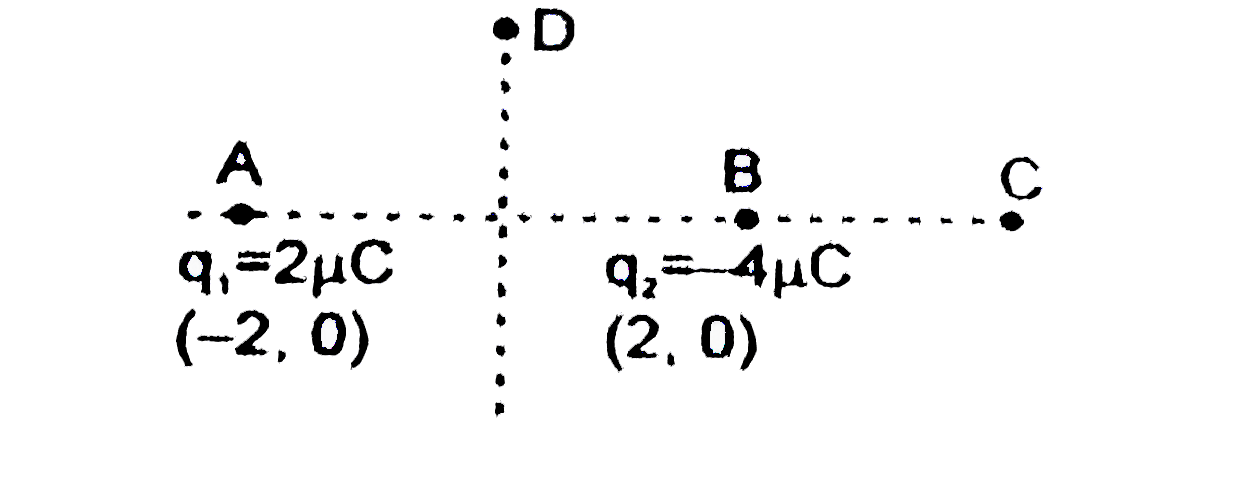An electric charge 10−3μC is placed at the origin (0, 0) of X-Y co-ordinate system. Two points A and B are situated at (√2,√2) and (2, 0) respectively. The potential difference between the points A and B will be
9 V
zero
2 V
3.5 V
The correct Answer is:B
To find the potential difference between points A and B due to a charge q=10−3μC placed at the origin, we can follow these steps:
Step 1: Identify the coordinates of points A and B
- Point A is located at (√2,√2).
- Point B is located at (2,0).
Step 2: Calculate the distances from the charge to points A and B
The potential V due to a point charge is given by the formula:
V=k⋅qr
where:
- k is Coulomb's constant (8.99×109N m2/C2),
- q is the charge,
- r is the distance from the charge to the point.
Distance from the charge to point A:
Using the distance formula:
rA=√(√2−0)2+(√2−0)2=√2+2=√4=2
Distance from the charge to point B:
Using the distance formula:
rB=√(2−0)2+(0−0)2=√4=2
Step 3: Calculate the potentials at points A and B
Now, we can calculate the potentials:
VA=k⋅qrA=k⋅(10−3×10−6)2
VB=k⋅qrB=k⋅(10−3×10−6)2
Step 4: Calculate the potential difference ΔV
The potential difference between points A and B is given by:
ΔV=VB−VA
Since both potentials are equal:
ΔV=k⋅(10−3×10−6)2−k⋅(10−3×10−6)2=0
Conclusion
The potential difference between points A and B is:
ΔV=0V
---
- Point A is located at (√2,√2).
- Point B is located at (2,0).
The potential V due to a point charge is given by the formula:
V=k⋅qr
where:
- k is Coulomb's constant (8.99×109N m2/C2),
- q is the charge,
- r is the distance from the charge to the point.
Using the distance formula:
rA=√(√2−0)2+(√2−0)2=√2+2=√4=2
Using the distance formula:
rB=√(2−0)2+(0−0)2=√4=2
Now, we can calculate the potentials:
VA=k⋅qrA=k⋅(10−3×10−6)2
VB=k⋅qrB=k⋅(10−3×10−6)2
The potential difference between points A and B is given by:
ΔV=VB−VA
Since both potentials are equal:
ΔV=k⋅(10−3×10−6)2−k⋅(10−3×10−6)2=0
The potential difference between points A and B is:
ΔV=0V
Topper's Solved these Questions
- ELECTROSTATIC POTENTIAL AND CAPACITORSBOOK - DC PANDEY ENGLISHCHAPTER - ELECTROSTATIC POTENTIAL AND CAPACITORSEXERCISE - (B) Chapter exercises
17 Videos
- ELECTROSTATIC POTENTIAL AND CAPACITORSBOOK - DC PANDEY ENGLISHCHAPTER - ELECTROSTATIC POTENTIAL AND CAPACITORSEXERCISE - (C) Chapter exercises
50 Videos
- ELECTROSTATIC POTENTIAL AND CAPACITORSBOOK - DC PANDEY ENGLISHCHAPTER - ELECTROSTATIC POTENTIAL AND CAPACITORSEXERCISE - Check point 2.5
20 Videos
- ELECTROMAGNETIC WAVESBOOK - DC PANDEY ENGLISHCHAPTER - ELECTROMAGNETIC WAVESEXERCISE - Sec C
22 Videos
- ELECTROSTATICSBOOK - DC PANDEY ENGLISHCHAPTER - ELECTROSTATICSEXERCISE - Medical entrances gallery
37 Videos
Similar Questions
A charge of 10μC is placed at the origin of x-y coordinate system. The potnetial difference between two point (0, a) and (a, 0) in volt will be
View SolutionAn isotropic point source 'S' of sound emits constant power. Two points A and B are situated at distance x and 2x from S. the difference between the loudness of points A and B is about (log 2=0.3)
View SolutionTwo point charges −q and +q are located at points (0,0−a) and (0,0,a) respectively. The electric potential at point (0,0,z)is (Z>a)
View Solutiontwo point charges 2μC and −4μC are situated at points (−2m,0m) and (2m,0m) respectively. Find out potential at point C(4m,0m) and D(0m,√5m).

View SolutionPoints A and B have co-ordinates (3, 4) and (0, 2) respectively. Find the image :
A" of A under reflection in the y-axis.
View SolutionPoints A and B have co-ordinates (3, 4) and (0, 2) respectively. Find the image :
A' of A under reflection in the x-axis.
View SolutionPoints A and B have co-ordinates (3, 4) and (0, 2) respectively. Find the image :
B" of B under reflection in the x-axis ".
View SolutionTwo point charge −q and +q/2 are situated at the origin and the point (a,0,0) respectively. The point along the X-axis where the electic field Vanishes is
View SolutionA point charge of 0.009μC is placed at origin.
Calculate intensity of electric field due to this point charge at point (√2,√7,0).
View SolutionTwo charges q1andq2 are placed at (0,0,d) and (0,0,-d) respectively. Find locus of points where the potential is zero.
View Solution
